Thrasher Studies the Use of Low-Stress Virtual Reality to Improve Students’ French Oral Proficiency
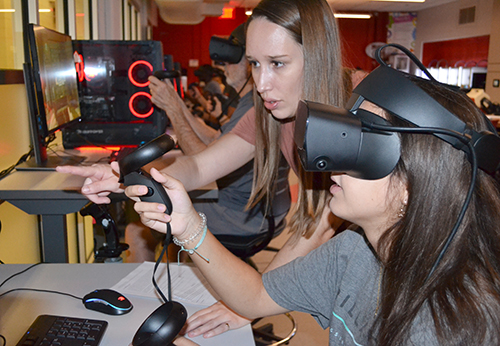
Tricia Thrasher (left) helps a French 205 student figure out how to use vTime at CITL's Innovation Studio.
October 11, 2019
Can virtual reality (VR) be used to decrease foreign language anxiety and increase students’ oral proficiency? French PhD student Tricia Thrasher thinks so. Consequently, students in French 205 were slated to employ VR in the Center for Innovation in Teaching & Learning’s (CITL’s) Innovation Studio, providing the perfect opportunity for her to study the impact.
According to Thrasher, who has a concentration in Second Language Acquisition and Teacher Education (SLATE), foreign language anxiety has been shown to negatively impact oral production skills. So, for her dissertation, she’s studying oral proficiency, specifically looking at how VR can be used to decrease foreign language anxiety, thus increasing oral production performance.
French 205: French Oral Proficiency is the perfect course for VR, and, thus, her study. Thrasher claims that “basically the entire course is just spent working on speaking and oral production skills. So not really writing. I think they probably do a little bit of grammar, like integrated into the syllabus…It's mostly geared towards conversation and speaking.”
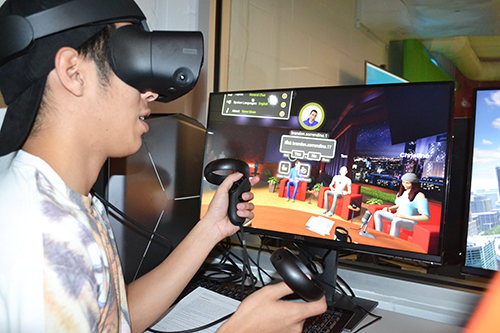
A student views his avatar and those of the rest of his group while practicing speaking with them.
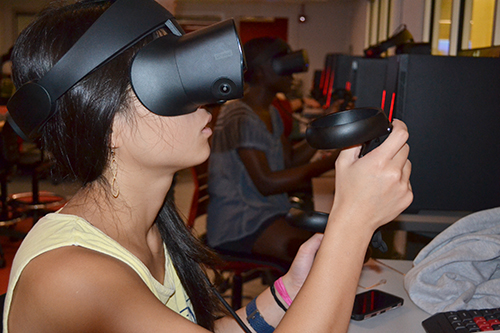
A French 205 student who is part of Thrasher's study enjoys using virtual reality to learn French.
So four times during the semester (every two weeks), students spent an hour in the VR lab in the Armory Building, practicing their French in a fun setting. Students used an app called vTime, a social VR experience. First they created an avatar which they could make look like them…or they could also be creative. Students practiced in groups of three. The student who had been designated the leader of the conversation would pick the destination and invite the two other people, who were automatically moved to that environment. For example, they could be at an outdoor French bistro in Paris, or on the side of a cliff, or even underwater. “Then they sit there, and they can talk to the people that they've chosen to communicate with,” she explains.
Thrasher shares why she chose vTime: “We wanted an app where they would focus primarily on speaking and that there wouldn't be a lot of distractions. And so that one [vTime] is really about just communicating with the people that you're in the conversation with.”
As part of her study, Thrasher measured students’ physiological responses, both in the VR lab and also among the remainder of the students back in the classroom setting. Also, following each class session, she administered surveys. Plus, after everyone had completed all four VR experiences, she conducted an interview with each student. Thrasher describes her procedure regarding the physiological measures:
"So I'm testing saliva samples for a hormone called cortisol," she reports, "and basically cortisol indicates your stress level. So when you are more anxious, your cortisol level is increased. And so when I collect it via saliva at the time of the study, it indicates how stressed they are in that moment. And so I'm comparing those. I'm collecting at 10 minutes into the activity in VR and 10 minutes into the activity in the classroom to see if there is a difference. And then I'm collecting their heart rate measures the entire time during both activities to see if they're more anxious in one than the other."
Early in the semester, one challenge was students learning how to use the app. “I knew there would be some learning curve,” she explains. She had actually done a previous pilot study last spring that was a little different than this, but the same idea. “Based on their feedback and all the data,” she says, “they were less stressed, and they did perform better. So that's why we're continuing.”
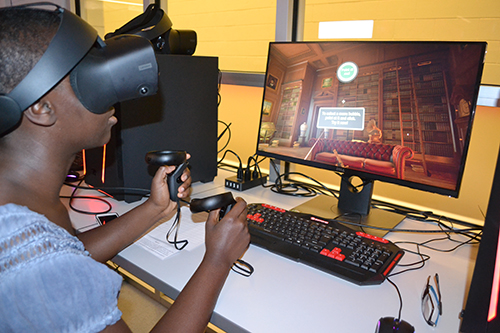
A French 205 student figures out how to use the vTime virtual reality app.
Thrasher’s current study was actually a preliminary study, which she’ll defend next spring; then, based on the results of this study, she’ll begin her official study to collect her dissertation data next year.
“I'm not sure in terms of methodology and app if it'll be the same, ‘cause it'll depend on what I find this semester and what changes I make. But it'll be the same general idea of using VR for decreasing anxiety and then improving performance.”
While it’s early in her research, she shares her tentative thesis statement: “I believe that students will be less stressed and will perform better. Because research has shown that when you're anxious, your muscles actually tense up, and so you don't perform as well in terms of speaking, and you also can't process.”
Thrasher shares why she picked this certain topic. “As a teacher, I know how detrimental anxiety can be,” she reports. She indicates that a recent study, a meta analysis on foreign language anxiety research, showed that it can have a huge impact on students’ success when learning a language. “And so I think, as a language teacher, you don't want negative factors like that impacting your students.”
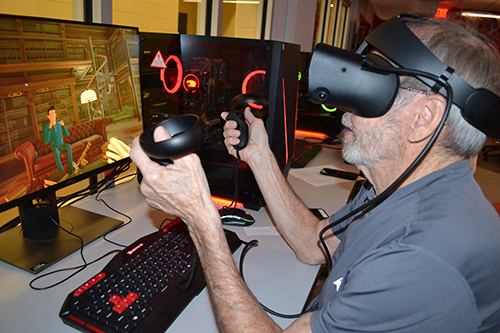
A French 205 student chats with fellow students during one of the VR sessions.
Might VR be a viable learning tool for, say, high school French or Spanish teachers who won’t necessarily have access to an Innovation Studio or high-tech VR headsets like those used there? Thrasher believes so. For instance, Google has cardboard VR headsets which are extremely cheap and something that would be accessible for schools. She says there’s also AR (augmented reality), which can just be apps on people's phones.
Regarding these other, less costly platforms, Thrasher would be interested in what the results of using those were. “I'd be curious to see,” she admits, “cause it's not as immersive. So I'd be curious to see what students thought of it.”
Her goal in this fall’s study is “Essentially to refine it for the dissertation, so to figure out what works.” While she wanted to get students’ feedback, she was mostly concerned with testing the physiological measures. "So with the heart rate monitors with the saliva samples, because that's something I've never worked with before. I've always just used questionnaires in the past," she reports.
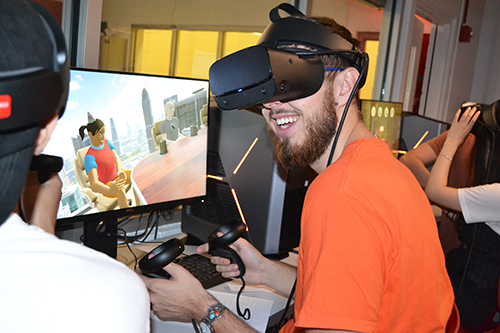
Junior Mitchell Halaska enjoys using virtual reality to learn French.
She adds that in research on foreign language anxiety, one needs objective measures. "So those types of things are what I really want to iron out in the fall," she continues. "And that way, once I defended in the spring, then I can really start doing data collection."
What were some of the benefits for the French 205 students? Now that Mitchell Halaska, a junior, has had a chance to experience using VR in order to brush up on his French oral proficiency, he believes it benefitted his learning. “Yes, it made for a memorable lesson with an in-depth and immersive environment,” he shares. He also admits that he would rather do VR than a regular classroom setting, qualifying, however, that that might be “because it is new and exciting!” His overall take on the use of VR to learn a language? “VR could be a valuable learning tool,” he acknowledges, “and it would be interesting to see how it develops.”
Thrasher shares what she percives is one of the benefits of using VR to improve students' oral proficiency.
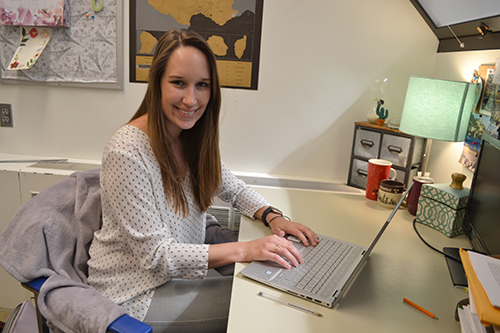
Tricia Thrasher, French PhD student with a concentration in Second Language Acquisition and Teacher Education (SLATE).
"They like that they have a chance to practice their language skills and they feel like it's less stressful since they are in their own little groups in VR. They don't feel as if they're as on display as they are when speaking for the whole classroom," she explains. In addition to it being a lower-risk situation where they could just talk and practice their French, she says her students seemed to having fun with the avatars and the app too. “But I think they're having the chance to talk and not feeling under pressure at the same time.”
Ironically, despite her advocacy for the use of VR to learn languages, Thrasher never actually used VR in order to learn personally. The French major gained proficiency via immersion—she lived abroad for two years. When learning French as an undergrad, she claims, “VR wasn't really a thing.” In fact, she says it’s just now beginning to be used in the classroom.
Thrasher’s goal, once she finishes her dissertation, of course, is to be a professor at an R-1 institution, either in a French department with a lot of linguistics and second language acquisition people, or a linguistics or ed psych department so she’d have more people to collaborate with. “Because I like to do research,” she acknowledges. “Yeah, that would be my dream job. Tenure track R-1 institution. But you know, we'll see.”
Story by Elizabeth Innes, Communications Specialist, I-STEM Education Initiative. Photos by Elizabeth Innes unless otherwise noted.
More: CITL, Student Spotlight, 2019
For more I-STEM articles about CITL's Innovation Studio, please see the following:
- The Next Best Thing to Being There—STEAM Studio Youngsters Explore the Amazon with the Help of CITL
- MakerGirl Seeks to Expand the STEM Pipeline by Getting Middle School Girls Interested in STEM
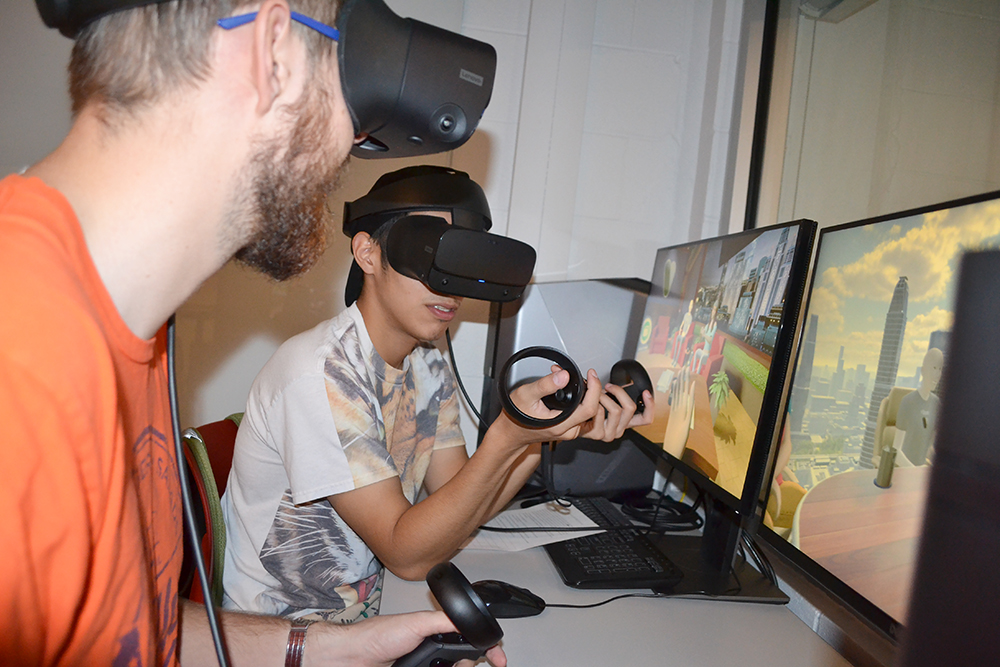
French 205 students interact while using VR to communicate French orally.













.jpg)
















